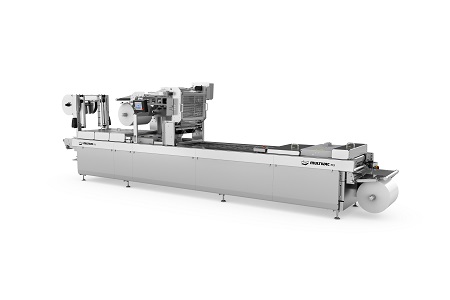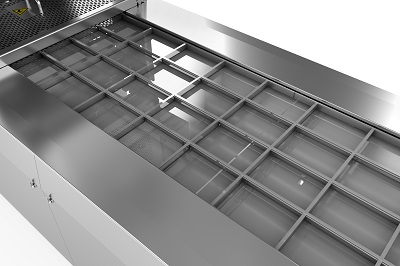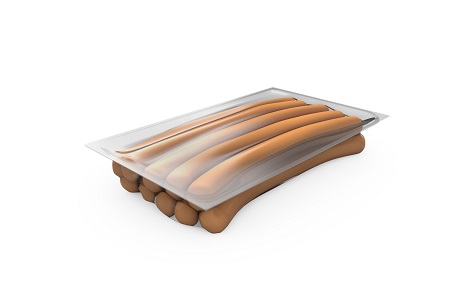The array of pack types and packaging materials for food is becoming more diverse every year. MULTIVAC has developed the R3 machine, so that food manufacturers can keep pace with this development. The R3 runs recyclable packaging films made of mono materials without crease formation, it requires very low levels of maintenance during everyday production thanks to new design features, and it fits into every production environment with its modular construction: The new R3 thermoforming packaging machine from MULTIVAC is predestined for the sustainable and cost-effective packaging operations of the future.

The new thermoforming packaging machine is not only designed to run the latest types of packaging materials, such as recyclable and environmentally-friendly mono films, very consistently and reliably. The machine can also be easily adapted to a wide range of customer requirements thanks to its advanced modular construction. In effect, a tailor-made suit for all events. “Our aim is to offer "best-fit" machine configurations to not only small and medium-sized companies, but also larger companies with tight budgets,” says Michael Landerer, Product Manager at MULTIVAC. “Cost-effective solutions, which are perfectly matched to the customer's production environment, and which are neither overdimensioned nor underdimensioned. Solutions, which at the same time incur the lowest possible maintenance costs.” The R3 will be available from July 2022.

R3 achieves the output of high-end slicer lines
The R3 consists of four stations: the forming station, the loading area, the sealing die and the cutting area. As the first stage, the forming station makes the lower web formable through the effect of heat, so that pack cavities for the product can be produced during the subsequent thermoforming process by means of compressed air and vacuum. After the thermoforming process is complete, the manual or automatic loading of the product into the pack cavities takes place. After the loading, the lower web is sealed hermetically to the upper web in the sealing die. The final stage is the severing of the individual packs from the strip of packs in the web by means of cross cutting units and a longitudinal cutter. “The R3 achieves a speed of twelve cycles per minute at its peak level and can therefore reach the output of high-end slicer lines,” says Michael Landerer.
Mono materials guaranteed crease-free: Allover heating prevents the formation of unsightly waves in the packaging film
In order to preserve the environment and halt the effects of climate change, it is necessary to turn away from the linear packaging economy to a closed-loop economy. But many plastic packs are not ready for this transformation. Why? Because they consist of multi-layer films, which cannot be recycled, but only incinerated. One solution: recyclable films made from mono materials, such as for example APET or PP. They are on the advance in the packaging world and improve the CO2 balance of plastic packs. But they often however have a worse visual appearance. In the case of many thermoforming packaging machines, they produce slight waves at the edges of the pack. “In order to solve this problem, we have equipped the R3 with allover heating, which heats recyclable films very evenly,” explains Michael Landerer. In addition to this, the chain guides for the web advance can be adjusted individually, and they are also decoupled from all the forces of the machine processes. This means for example, that the weight of the die set is borne entirely on the side frames. Therefore, no vibrations are transmitted to the film. “This enables us to achieve a constant web tension and consistently prevent waves at the edges of the pack. This therefore guarantees the optimum pack appearance with films made from mono materials such as polypropylene.”

New design of lifting unit and sealing plate reduces maintenance worry
The R3 is designed in such a way, that maintenance work is minimal. This is proven by the design of the new lifting unit. “The development team has reduced the number of moving parts to a minimum. In addition to this, lubricant is not used anywhere,” says Michael Landerer. “The amount of maintenance work and the potential occurrence of faults are therefore very small.” Even the changing of the sealing plate can be completed very quickly. Up to now service technicians often had to lift the complete top section of the die. This means 100 kilograms, which is enough to raise a sweat. MULTIVAC's solution: The sealing plate, which only weighs around 20 kilograms, can be simply removed from the top section by means of screws and pulled into the loading area. There the change can be carried out quickly and with minimum effort. “The cooling water circuit in the top section remains unaffected. That is a huge benefit. It means that it is no longer necessary to drain the cooling water. A task, which in the past has not only cost time, but also involved a contamina-tion risk.” And last but not least, the designers have reinforced the un-derside of the frame on the thermoforming packaging machine. This makes it possible to lift the entire machine at a central point - for exam-ple with a forklift. “Thanks to this reinforcement, it is possible to quickly alter the position of the machine in the event of any line changes.”














